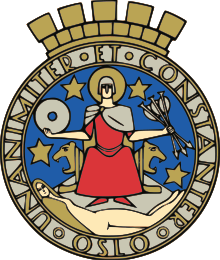- Seal of Oslo
-
Oslo is one of very few cities in Norway, besides Bergen and Tønsberg, that do not have a formal coat of arms, instead using a city seal. The City Seal of Oslo shows the city's patron saint, St. Hallvard. The seal shows St. Hallvard with his attributes, the millstone and arrows, with a nude woman by his feet. He is seated on a throne with lion decorations, which at the time was also commonly used by the Norwegian kings.
The oldest known seal of Oslo showed the same composition as today's seal, except the human figure reclining at the feet of St. Hallvard. In the original seal, it represented an armed warrior, one of the evil men who killed Hallvard. Due to its bad state of preservation, the image was misinterpreted as the woman whom Hallvard tried to defend. The seal was probably made around 1300 and was in use for nearly three centuries. After the Reformation, the city continued the use of St. Hallvard in its seal. The second seal of Oslo dates from around 1590. It shows the same basic design, but the saint holds his attributes in the opposite hands. Also the stars and some other smaller details were lost. This seal was used until around 1660.
At that time the Church of St. Hallvard had become a ruin and the legend was no longer well known. The third seal of Oslo, made in 1659, therefore still showed the basic design, but the saint was transformed into a female figure. She still held the arrows and had a dead knight (with harness and helmet) lying at her feet. The millstone had become thinner and looked more like a ring. This image can still be seen on a cast iron stove plate dating from 1770. These plates became very popular in Denmark in the 18th century and the figure was presented as Queen Margaret I, who unified the three Kingdoms of Sweden, Norway, and Denmark, which are represented by the ring (union) and the three arrows. The dead knight was to symbolise her opponent, Albrecht of Mecklenburg.
During the 18th and early 19th century, the image kept changing. The ring has been shown as a snake biting its own tail, the throne was replaced by a lion, and the warrior at Hallvard's feet definitely became a woman.
In 1854, A. T. Kaltenborn wrote about the Norwegian municipal arms and also was shown a medieval seal of Oslo. He recognised it as depicting the legend of St. Hallvard, but did not interpret the reclining figure correctly. He persuaded the city to have a new seal made, based on the alleged medieval composition. Finally a new design was made by the German E. Doepler in 1892. His composition was also used on a proper shield, designed in 1899 by Reidar Haavin. In 1924, the present design was made, still with the incorrect woman instead of the original warrior, but now stark naked.[1]
References
- ^ Norske Kommunevåpen (1990). "Nye kommunevåbener i Norden". http://www.ngw.nl/int/nor/o/oslo.htm. Retrieved 20 December 2008.
Categories:- Government and politics of Oslo
- Seals (insignia)
Wikimedia Foundation. 2010.

